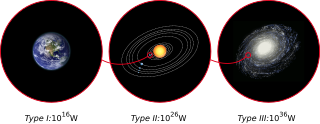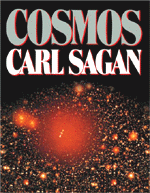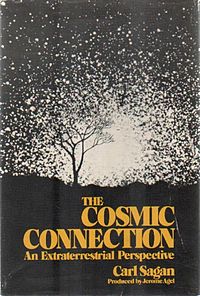
Ann Druyan is an Emmy and Peabody Award-winning American writer, producer, and director specializing in the communication of science. She co-wrote the 1980 PBS documentary series Cosmos, hosted by Carl Sagan, whom she married in 1981. She is the creator, producer, and writer of the 2014 sequel, Cosmos: A Spacetime Odyssey and its sequel series, Cosmos: Possible Worlds, as well as the book of the same name. She is credited with directing episodes of both series as well.

Carl Edward Sagan was an American astronomer, planetary scientist, cosmologist, astrophysicist, astrobiologist, author, and science communicator. His best known scientific contribution is research on extraterrestrial life, including experimental demonstration of the production of amino acids from basic chemicals by radiation. Sagan assembled the first physical messages sent into space: the Pioneer plaque and the Voyager Golden Record, universal messages that could potentially be understood by any extraterrestrial intelligence that might find them. Sagan argued the now-accepted hypothesis that the high surface temperatures of Venus can be attributed to and calculated using the greenhouse effect.

Frank Donald Drake is an American astronomer and astrophysicist. He is involved in the search for extraterrestrial intelligence, including the founding of SETI, mounting the first observational attempts at detecting extraterrestrial communications in 1960 in Project Ozma, developing the Drake equation, and as the creator of the Arecibo Message, a digital encoding of an astronomical and biological description of the Earth and its lifeforms for transmission into the cosmos.

The Kardashev scale is a method of measuring a civilization's level of technological advancement based on the amount of energy it is able to use. The measure was proposed by Soviet astronomer Nikolai Kardashev in 1964.

The Voyager Golden Records are two phonograph records that were included aboard both Voyager spacecraft launched in 1977. The records contain sounds and images selected to portray the diversity of life and culture on Earth, and are intended for any intelligent extraterrestrial life form who may find them. The records are a sort of time capsule.

Contact is a 1985 hard science fiction novel by American scientist Carl Sagan. It deals with the theme of contact between humanity and a more technologically advanced, extraterrestrial life form. It ranked No. 7 on the 1985 U.S. bestseller list. The only full work of fiction published by Sagan, the novel originated as a screenplay by Sagan and Ann Druyan in 1979; when development of the film stalled, Sagan decided to convert the stalled film into a novel. The film concept was subsequently revived and eventually released in 1997 as the film Contact starring Jodie Foster.

Iosif Samuilovich Shklovsky was a Soviet astronomer and astrophysicist. He is remembered for work in theoretical astrophysics and other topics, as well as for his 1962 book on extraterrestrial life, the revised and expanded version of which was co-authored by American astronomer Carl Sagan in 1966 as Intelligent Life in the Universe.

The Demon-Haunted World: Science as a Candle in the Dark is a 1995 book by the astrophysicist Carl Sagan and co-authored by Ann Druyan, in which the author aims to explain the scientific method to laypeople and to encourage people to learn critical and skeptical thinking. He explains methods to help distinguish between ideas that are considered valid science and those that can be considered pseudoscience. Sagan states that when new ideas are offered for consideration, they should be tested by means of skeptical thinking and should stand up to rigorous questioning.

Jill Cornell Tarter is an American astronomer best known for her work on the search for extraterrestrial intelligence (SETI). Tarter is the former director of the Center for SETI Research, holding the Bernard M. Oliver Chair for SETI at the SETI Institute. In 2002, Discover magazine recognized her as one of the 50 most important women in science.

The SETI Institute is a not-for-profit research organization incorporated in 1984 whose mission is to explore, understand, and explain the origin and nature of life in the universe, and to apply the knowledge gained to inspire and guide present and future generations. It aims for discovery and for sharing knowledge as scientific ambassadors to the public, the press, and the government. SETI stands for the "search for extraterrestrial intelligence". The Institute consists of three primary centers: The Carl Sagan Center, devoted to the study of life in the universe, the Center for Education, focused on astronomy, astrobiology and space science for students and educators, and the Center for Public Outreach, producing "Big Picture Science," the Institute's general science radio show and podcast, and "SETI Talks" weekly colloquium series.

Pale Blue Dot is a photograph of planet Earth taken on February 14, 1990, by the Voyager 1 space probe from a record distance of about 6 billion kilometers, as part of that day's Family Portrait series of images of the Solar System.

Communication with extraterrestrial intelligence or CETI, is a branch of the search for extraterrestrial intelligence that focuses on composing and deciphering interstellar messages that theoretically could be understood by another technological civilization. The best-known CETI experiment of its kind was the 1974 Arecibo message composed by Frank Drake.

A Dyson tree is a hypothetical genetically engineered plant capable of growing inside a comet, suggested by the physicist Freeman Dyson. Plants may be able to produce a breathable atmosphere within the hollow spaces of the comet, utilising solar energy for photosynthesis and cometary materials for nutrients, thus providing self-sustaining habitats for humanity in the outer solar system analogous to a greenhouse in space, a shell grown by a mollusc or the actions of thermogenic plants, such as the skunk cabbage or the voodoo lily.

Cosmos is a 1980 popular science book by astronomer and Pulitzer Prize-winning author Carl Sagan. Its 13 illustrated chapters, corresponding to the 13 episodes of the Cosmos TV series, which the book was co-developed with and intended to complement, explore the mutual development of science and civilization. One of Sagan's main purposes for the book and television series was to explain complex scientific ideas to anyone interested in learning. Sagan also believed the television was one of the greatest teaching tools ever invented, so he wished to capitalize on his chance to educate the world. Spurred in part by the popularity of the TV series, Cosmos spent 50 weeks on the Publishers Weekly best-sellers list and 70 weeks on the New York Times Best Seller list to become the best-selling science book ever published at the time. In 1981, it received the Hugo Award for Best Non-Fiction Book. The book's unprecedented success ushered in a dramatic increase in visibility for science-themed literature. The success of the book also jumpstarted Sagan's literary career. The sequel to Cosmos is Pale Blue Dot: A Vision of the Human Future in Space (1994).

Billions and Billions: Thoughts on Life and Death at the Brink of the Millennium is a 1997 book by the American astronomer and science popularizer Carl Sagan. The last book written by Sagan before his death in 1996, it was published by Random House.

Pale Blue Dot: A Vision of the Human Future in Space is a 1994 book by the astronomer Carl Sagan. It is the sequel to Sagan's 1980 book Cosmos and was inspired by the famous 1990 Pale Blue Dot photograph, for which Sagan provides a poignant description. In the book, Sagan mixes philosophy about the human place in the universe with a description of the current knowledge about the Solar System. He also details a human vision for the future.
Jon Lomberg is an American space artist and science journalist. He was Carl Sagan's principal artistic collaborator for more than twenty years on many projects from 1972 through 1996. In 1998, the International Astronomical Union officially named an asteroid in recognition of his achievements in science communication.

EdmondHalley, FRS was an English astronomer, geophysicist, mathematician, meteorologist, and physicist. He was the second Astronomer Royal in Britain, succeeding John Flamsteed in 1720.

A planetary civilization or global civilization is a civilization of Type I on Kardashev scale, with energy consumption levels near that of a contemporary terrestrial civilization (near 1013 watts), with an energy capability equivalent to the solar insolation on Earth (between 1016 and 1017 watts). In social aspect – the worldwide, global, increasingly interconnected, international, highly technological society.



















